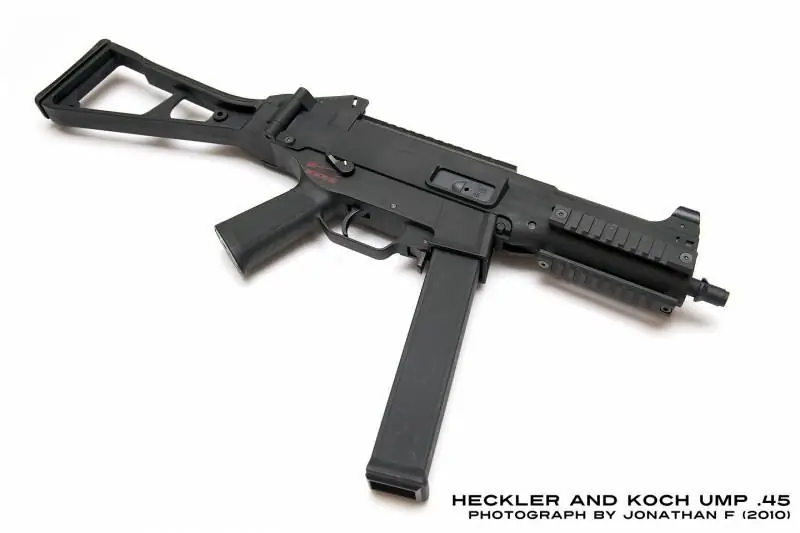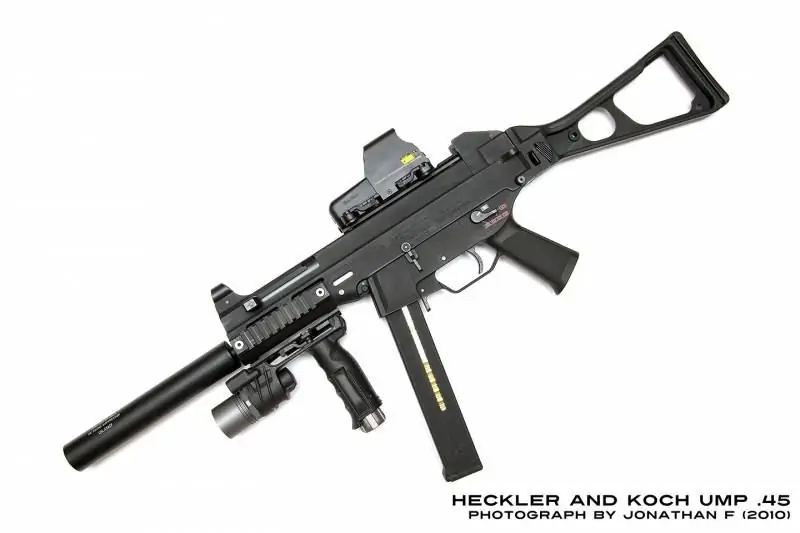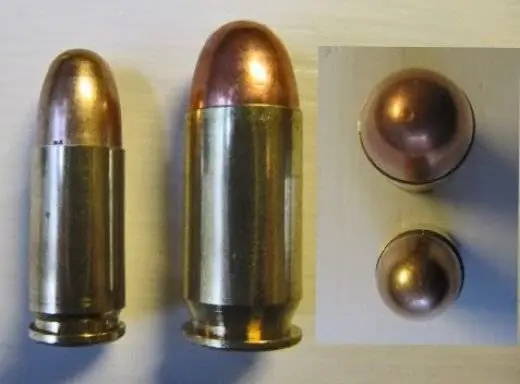- Author Matthew Elmers [email protected].
- Public 2023-12-16 21:49.
- Last modified 2025-01-24 09:17.
The UMP (Universal Machinen Pistole) submachine gun manufactured by the famous German arms company Heckler & Koch might not have been included in the rating of the most powerful small arms if it had not been produced for cartridges of various calibers. The most powerful version of this versatile UMP45 submachine gun is chambered for.45 ACP (11, 43x23 mm). This model of firearms combines high stopping action of a bullet, moderate recoil and high accuracy of fire. Unlike the Desert Eagle pistol, the UMP submachine gun, even in its modification chambered for a rather powerful.45 ACP cartridge, is used by special forces and army units of some countries, and its younger brothers chambered for 9 × 19 mm Parabellum or.40S & W (10x22 mm) are even more common wide.
Engineers at Heckler & Koch created the UMP versatile submachine gun in the 1990s as a complement to the HK MP5 family of submachine guns that are popular and renowned around the world. The design of the new model was simplified, but at the same time more modern materials were used in the construction of the UMP. The company initially planned to offer its model on the police weapons market in the United States, so it chose for it the.40S & W and.45 ACP ammunition popular in America, a variant of a submachine gun chambered for 9x19 mm Parabellum appeared later.
Currently, there are three varieties of the UMP submachine gun: the most powerful UMP45, designed for the.45 ACP pistol cartridge, the UMP40, respectively, for the.40S & W cartridge and the UMP9 for the 9 × 19 mm Parabellum cartridge. Despite the difference in the caliber of the weapon, all three submachine guns have the same design, the external difference between the three models from each other lies only in the shape of the store. For submachine guns in large calibers - a straight magazine, for a 9x19 mm Parabellum cartridge - curved. All three versions can, if desired, be easily transformed into each other by replacing the barrel, bolt and magazine; during development, the Germans implemented the modularity of the design of the submachine gun.

In addition to the three listed versions, one civilian is also presented on the market - this is the USC (Universal Self-loading Carbine) - a universal self-loading carbine. It was designed specifically for further export to the United States and met all American civilian weapons standards. The carbine differs from its combat counterparts in the shape of the butt, a longer barrel, a magazine limit of 10 rounds (at the time of development in the United States, there were restrictions on the capacity of magazines for civilian weapons), while USC magazines are not compatible with combat versions, and the carbine also does not have a pistol grip fire control and there is no possibility to conduct automatic fire. This civilian version can be used for sporting purposes or for self-defense. Sales of the USC carbine were discontinued in 2013.
It should be noted that the designers of Heckler & Koch took almost six months to create a submachine gun capable of firing bursts of cartridges of such a large caliber as.45APC. Initially, they tested the same semi-breechblock scheme that was implemented in their MP5 submachine gun and was traditional for the company. However, this scheme could not withstand the long-term operation of the weapon, as a result of which the new submachine gun failed after 5 thousand shots. As a result, the engineers of the German company switched to a free gate circuit.
The German HK UMP45 submachine gun is a small arms built according to the breechblock scheme. The principle of automatic action is used - recoil of a free bolt, fire from a submachine gun is fired from a closed bolt. The trigger mechanism is hammer. The weapon has a double-sided safety switch for fire modes, as well as a slide delay, which ensures that the slide stops in the open position after all the cartridges are used up in the magazine. The following modes of fire are available to the shooter: single shots, automatic fire, and optionally, bursts with a cut-off of 2 or 3 shots can be optionally available. Since the UMP submachine gun was originally created for firing large caliber cartridges, as well as due to the difficulties in feeding.45 ACP cartridges compared to the usual 9x19 mm, the technical rate of fire was artificially limited to 600 rounds per minute, which makes this submachine gun one of the slowest in the international market.

The UMP submachine gun compares favorably with its low weight, the UMP9 is 0.75 kg lighter at once than the MP5 A3 submachine gun similar to it, this is due to the wide use of modern shock-resistant plastic in the UMP design, which not only allowed to seriously reduce the weight of the weapon, but provided its resistance to corrosion. The bolt box of the submachine gun is made of plastic; a trigger box made of plastic with a magazine receiver and a pistol grip is also attached to it from below. Impact-resistant plastic has good resistance to damage and stress, which allows you to freely use the weapon in the field. The mass of the UMP9 submachine guns without a magazine is only 2.35 kg, the mass of the UMP45 submachine gun without a magazine is 2.47 kg.
The UMP45 pistol grip has a rounded shape and small notches along the cheeks and butt pad, at its base there is a small protrusion under the arrow's little finger for a more comfortable grip. The trigger guard is large, it is possible to fire a submachine gun with gloves or hold the weapon by passing your left thumb through the clip (as in the Beretta 93R). The magazine latch is straight, like in a Kalashnikov assault rifle, it is made of metal and has deep corrugation, the stroke is short and precise, while the magazine is not removed from the weapon, but falls out like pistols.
The fire mode switch is double-sided, reversible (the lever is directed towards the butt of the submachine gun), it has three positions:
- extreme upper position - blocking of the striker and hammer, while the trigger is still pressed;
- middle position - fire with single shots;
- extreme lower position - automatic fire, switching on occurs with a slight click.

The submachine gun has the ability to replace the fully automatic fire mode with firing in short bursts of 2 or 3 rounds. For such a replacement, you need to change the self-cocking lever or install another trigger module on the weapon. This module is fixed to the weapon by means of two "fangs", which are located in front of the magazine receiver, and a long bolt connecting it to the receiver and located behind the translator of fire modes.
The UMP45 uses a butt that folds to the right side (some consider this option more convenient than the MP5), it can be locked in the unfolded position. The folding skeletal buttstock with two notches of the UMP45 submachine gun, unlike the receiver, is reinforced and has an aluminum frame, which significantly increases its strength. True, given the fact that the butt fixing elements are made of plastic, they should be hit on something with some caution. With the stock unfolded, the UMP45 is 695 mm long, with the stock folded 455 mm.
On the upper part of the UMP45 receiver there are sights, which are used as a conventional rear sight and front sight. Entirely on both sides is reliably protected by the protrusions of the receiver. This is important when operating in tight spaces and urban areas, where the weapon can accidentally hit an obstacle. The rear sight is also placed in a protective ring. A Picatinny rail can be installed between the sights on top of the receiver, which allows the shooter to install various optical or collimator sights. In total, it is possible to mount four Picatinny rails on a submachine gun - on the bolt box on the top, right, left and bottom of the body. The ability to mount a vertical front grip on the UMP can greatly assist the shooter in automatic fire from a weapon.

The barrel of the submachine gun is devoid of any compensators in its muzzle, but at the same time it has a mount for a silent and flameless firing device. The greatest efficiency is achieved when using such a device with subsonic cartridges. The standard barrel length of all three models of the UMP submachine gun is 200 mm, the USC civilian carbine had a barrel length of 400 mm.
Together with the submachine gun, straight-shaped box magazines for.45APC and.40S & W cartridges and forward curved for 9x19 mm Parabellum cartridges could be used. Magazine capacity chambered for.40S & W and 9x19 mm is 30 rounds, magazine capacity chambered for.45APC is 25 rounds. Like the receiver, the magazines of the submachine gun are made of plastic. On their sidewalls there are special slots covered with transparent plastic. These slots are used for convenient control of ammunition consumption.

Comparison of 9x19 mm and.45APC cartridges
In general, it can be noted that all UMP submachine guns are excellent for combat in urban settings or in buildings, including in confined spaces. The weapon is lightweight and lightweight, and also provides the shooter with ample opportunities for upgrades and installation of various tactical attachments. The modularity of the weapon and the ability to change the caliber also should not be discounted. The UMP45 variant is a very powerful firearm, especially in the submachine gun class. The.45ACP bullet (11, 43x23 mm) has a very strong stopping effect (albeit a small penetrating effect), but now imagine that a whole line of such bullets is flying at the target. The version of the submachine gun for this cartridge, according to Wikipedia, is used by the special forces of Lithuania and Georgia, and the UMP45 is also used by the special forces of Malaysia, the Philippines and Egypt.






